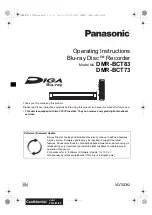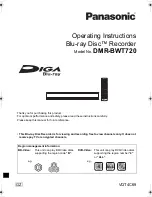
85
RQT8896
JPEG (Joint Photographic Experts Group)
This is a system used for compressing/decoding colour still pictures.
If you select JPEG as the storage system on digital cameras, etc.,
the data will be compressed to 1/10–1/100 of its original size. The
benefit of JPEG is less deterioration in picture quality considering
the degree of compression.
LPCM (Linear PCM)
These are uncompressed digital signals, similar to those found on
CDs. LPCM sound is available when recording in XP mode.
MPEG2 (Moving Picture Experts Group)
A standard for efficiently compressing and expanding colour video.
MPEG2 is a compression standard used for DVD and satellite based
digital broadcasting. This unit records programmes using MPEG2.
SD Video files shot with a Panasonic SD video camera, etc. can be
copied to the HDD or a DVD-RAM disc.
MP3 (MPEG Audio Layer 3)
An audio compression method that compresses audio to
approximately one tenth of its size without any considerable loss of
audio quality. You can play MP3 you have recorded onto CD-R and
CD-RW.
Pan&Scan/Letterbox
In general, DVD-Video are produced with the intention that they be
viewed on a widescreen television (16:9 aspect ratio), so images
often don’t fit regular (4:3 aspect ratio) televisions. Two styles of
picture, “Pan & Scan” and “Letterbox”, deal with this problem.
Pan & Scan:The sides are cut off so the picture fills
the screen.
Letterbox:Black bands appear at the top and bottom
of the picture so the picture itself appears in
an aspect ratio of 16:9.
Playback control (PBC)
If a Video CD has playback control, you can select scenes and
information with menus.
(This unit is compatible with version 2.0 and 1.1.)
Progressive/Interlace
The PAL video signal standard has 576 (or 625) interlaced (i) scan
lines, whereas progressive scanning, called 576p (or 625p), uses
twice the number of scan lines. For the NTSC standard, these are
called 480i (or 525i) and 480p (or 525p) respectively.
Using progressive output, you can enjoy the high-resolution video
recorded on media such as DVD-Video.
Your television must be compatible to enjoy progressive video.
Panasonic televisions with 576 (625)/50i · 50p, 480 (525)/60i · 60p
input terminals are progressive compatible.
Protection
You can prevent accidental deletion by setting writing protection or
deletion protection.
RGB
This refers to the three primary colours of light, red (R), green (G),
and blue (B) and also the method of producing video that uses them.
By dividing the video signal into the three colours for transmission,
noise is reduced for even higher quality images.
Sampling frequency
Sampling is the process of converting the heights of sound wave
(analog signal) samples taken at set periods into digits (digital
encoding). Sampling frequency is the number of samples taken per
second, so larger numbers mean more faithful reproduction of the
original sound.
Thumbnail
This refers to a miniature representation of a picture used to display
multiple pictures in the form of a list.
1080i
In one high definition image, 1080 (1125) alternating scan lines pass
every 1/50
th
of a second to create an interlace image. Because
1080i (1125i) more than doubles current television broadcasts of
480i (525i), the detail is much clearer and creates a more realistic
and rich image.
1080p
In one high definition image, 1080 (1125) scan lines pass at the
same time every 1/50
th
of a second to create a progressive image.
Since progressive video does not alternate scan lines like interlace,
there is a minimal amount of screen flicker.
720p
In one high definition image, 720 (750) scan lines pass at the same
time every 1/50
th
of a second to create a progressive image. Since
progressive video does not alternate scan lines like interlace, there
is a minimal amount of screen flicker.
G
lo
ssa
ry
EH57_67.book Page 85 Tuesday, January 30, 2007 9:29 AM



































